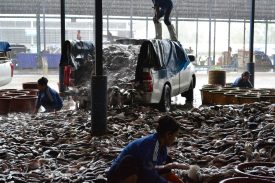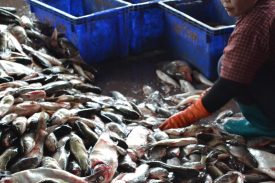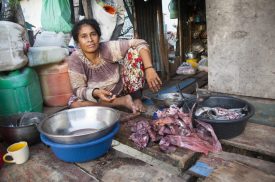Women in Stem Part 2: Bringing Visibility to Women in Fisheries
By Angela Cruz

When you hear “fisherman,” what do you picture? I would expect you see an image of a burly man in a yellow raincoat, struggling on a hazardous sea. Men have been the face of the marine resource industry and discourse for decades, with the assumption that it is a strictly male sphere. Previously, reports stated that the global fishing industry was overwhelmingly dominated by men. However, this statistic has been turned on its head. Today, the World Bank acknowledges that when pre-harvest, post-harvest and subsistence activities are considered, the fishing industry is nearly 50% women. As Currents recognizes and discusses women in STEM, it’s equally important to include women that work in the fisheries industry and the biases they experience in that discussion as well. When we don’t understand women’s roles in fisheries, this can render them invisible in the industry. These biases and invisibility can lead to exclusion of women in fisheries management, even though they hold great stake in marine resources and are more vulnerable to environmental degradation than men. This can have negative repercussions both for management outcomes and for communities.

There are many reasons this miscalculation of gender participation in fisheries has occurred. First, women’s activities in the marine resource sector tend to occur in the household and out of sight. Though women are fishers too, the majority of their participation is in the pre- and post-harvest stage: mending nets, collecting bait, and processing fish in their homes. The ability to work from home allows women to maintain their roles as caretakers to children and other family members. Simultaneously, this can make women less visible in the public decision-making sphere and their duty to watch after children may inhibit their participation in public consultations regarding marine resources. Second, women often use the marine environment in ways that are informal, unpaid, or for subsistence (e.g. food for consumption in the household). These activities don’t fit into the narrowly defined box of what we typically call “fishing” and are often unreported, making it difficult to assess women’s contributions. For example, gleaning is a very common activity for women in coastal communities around the world but is hardly ever accounted for. Gleaning refers to walking around the reef flat at low-tide, collecting different invertebrates such as snails. Because these activities are unpaid, they’re often viewed as “supplemental” and not in need of management. If changes occur in the resources, managers won’t have baseline information as there’s very little quantitative information available on collection and actors. This lack of attention to management of women’s common resources can have negative ramifications for household nutrition and food security.

It’s impossible to describe all the ways that women participate in the fisheries industry and how they are systematically excluded from formal decision-making bodies in one blog post. Women’s roles in the fishing industry are contextual and highly variable. Women tend to have more diverse livelihoods than men, filling different roles as needed, and we still know very few specifics about how women interact with the ocean and coastal zone around the world. There is an international push for practitioners and managers to apply a gender lens when conducting fisheries management and conservation projects. Whether you say, “applying a gender lens,” “feminist approach,” or “gender mainstreaming,” you’re essentially saying: an intentional and systematic inclusion of women and other marginalized groups in projects that seeks to correct gender inequities. This will look different from project to project and place to place. A project applying a gender lens works with men and women to access the vital knowledge they collectively hold, to differentiate the risks they experience, and to address all the concerns and priorities felt by communities. Applying a gender-lens to resource management can improve food security, improve environmental outcomes, and in turn, improve societal incomes for women, men, and children.
So, with all this information we have begun to collect on women’s roles in fisheries and the evidence of benefits from their participation, how are we doing? Unfortunately, not as well as we could. According to the World Wide Fund for Nature (WWF), less than 1% of peer-reviewed conservation papers have a gender-dimension, and though people are aware of the importance of gender work, the implementation of it is sporadic. It is critical that a gender lens is applied consistently to management and conservation efforts to achieve the best possible outcomes and simultaneously decrease gender inequalities. From there, women in fishing communities can, and should, be equitably represented in formal decision-making forums regarding marine resources.
We have made great strides in increasing representation of women in ocean science. It is time that women marine resource users are increasingly represented in decision-making bodies following that same upward trend, and it all begins with awareness and visibility. After all, women’s rights are human rights and working towards gender equality in all sectors, including fisheries, makes our society better as a whole.
In the interest of sharing scientific knowledge, we do our best to cite sources that are free and available for all of our readers. However, sometimes we cannot avoid citing articles that restrict access with a paywall. If you are interested in learning more about a specific source, please reach out to kmartin8@uw.edu.